What is Hosted Unified Communications? Best Hosted UC Providers for 2025
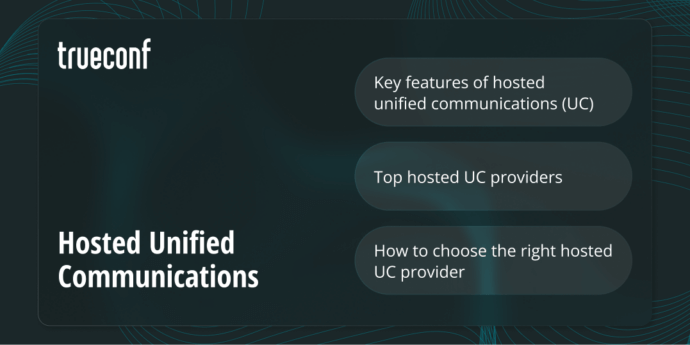
What Is Hosted Unified Communications?
Hosted Unified Communications (Hosted UC) describes a cloud-driven architecture that combines diverse enterprise communication solutions—such as voice calls, video meetings, instant chat, presence tracking, document exchange, and collaborative workspaces—within one integrated environment. In contrast to conventional on-site PBX infrastructures, hosted UC services are administered and supported by an external provider.
This methodology enables companies to simplify internal and external communication while avoiding large expenditures on physical hardware or complex IT maintenance. Team members are able to interact and cooperate through a centralized interface accessible from anywhere and on any device, thereby enhancing agility, scalability, and overall operational efficiency.
The Features Of Hosted Unified Communications
1. VoIP calling
At the core of every Hosted UC solution rests Voice over Internet Protocol (VoIP)—a transformative innovation enabling users to make and manage voice communications over digital networks instead of relying on standard landline infrastructure.
VoIP ensures significant cost optimization, global accessibility, and advanced capabilities such as intelligent call management, unified voicemail-to-email functionality, and superior audio performance. Businesses benefit from flexible numbering options, effortless scalability, and reliable connectivity without the necessity for conventional PBX equipment expenditures.
2. Video conferencing
Video conferencing introduces real-time interaction into the modern digital environment. Hosted UC systems feature integrated conferencing utilities that provide support for HD visuals, content sharing, session recording, and customizable virtual backgrounds. Such capabilities strengthen team cooperation, facilitate hybrid collaboration, and assist organizations in sustaining effective communication across remote and on-site teams.
Enhanced functionalities such as live transcription services and dedicated breakout spaces further boost efficiency and participant engagement throughout virtual sessions.
3. Unified messaging
Unified messaging integrates several communication channels—including emails, voice recordings, text alerts, and real-time chats—into a single, cohesive interface. This structure empowers employees to access, manage, and respond to messages efficiently within one unified application ecosystem.
By merging communication mediums, organizations boost productivity and ensure that no critical interaction is missed across different systems. Connectivity with CRM solutions and task management platforms additionally promotes optimized operations and reinforces both customer and internal collaboration.
4. Mobile and desktop app support
Hosted UC solutions provide specialized applications for both desktop and mobile platforms, allowing individuals to place calls, exchange messages, and participate in video conferences from any location.
This multi-device accessibility guarantees uniform functionality and experience across all hardware types. Staff members can initiate a conversation on their computer and resume it effortlessly on a smartphone—perfect for the modern mobile-centric and hybrid workplace ecosystem.
5. AI-powered tools
Artificial intelligence is evolving into a core element within modern Hosted UC ecosystems. AI-driven capabilities encompass automated meeting summaries, background noise filtering, voice analysis, and virtual assistants designed to simplify repetitive communication activities.
Furthermore, AI-enabled analytics tools can detect behavioral trends and patterns in organizational communication, enabling leaders to optimize workflows, boost customer satisfaction, and foster stronger employee engagement.
6. Enterprise-grade security
Protection stands as a crucial cornerstone of all Hosted UC implementations. Leading vendors employ advanced encryption protocols, layered authentication systems, secure data centers, and rigorous compliance with global standards such as GDPR, HIPAA, and ISO 27001.
Continuous risk detection, role-based access control, and extensive audit documentation ensure that sensitive data remains protected while maintaining full regulatory alignment throughout diverse operational environments.
Top 6 Hosted UC Providers (2025)
1. TrueConf

TrueConf distinguishes itself as a robust, privacy-focused, and hybrid-ready Unified Communications (UC) platform developed specifically for enterprises, public institutions, and organizations that enforce rigorous data protection policies. In contrast to numerous UCaaS vendors depending heavily on public cloud frameworks, TrueConf provides comprehensive authority over both information management and deployment models — a vital benefit for industries adhering to internal or governmental security standards.
The solution integrates video collaboration, team messaging, presence tracking, and productivity tools into a unified, intuitive interface. Whether implemented on-site or within a private environment, TrueConf guarantees full data autonomy while delivering enterprise-level stability and reliability.
Key Features
- Self-Hosted or Private Cloud Deployment: TrueConf can be set up directly inside an organization’s own infrastructure or maintained as a dedicated private cloud service.
- Full HD and 4K Video Conferencing: The system supports ultra-HD communication with optimized bandwidth usage, dynamic bitrate adjustment, and hardware acceleration, ensuring consistent, high-quality connections even on restricted networks.
- Integration with SIP/H.323, Active Directory, and Enterprise Systems: TrueConf smoothly connects with traditional conferencing devices (Poly, Cisco, Lifesize) and corporate directories, simplifying integration into existing IT ecosystems.
- AI-Powered Meeting Tools: Embedded AI functions elevate collaboration with auto-framing, virtual scenes, and smart sound suppression, fostering professional meeting environments.
- Cross-Platform Client Applications: TrueConf delivers native clients for Windows, macOS, Linux, iOS, Android, and web browsers, ensuring universal access across devices.
- Advanced Administration and Security: Components such as comprehensive encryption, access-level control, and detailed audit trails make the platform ideal for entities operating under GDPR, HIPAA, or national cybersecurity mandates.
Best For
Organizations emphasizing data protection, on-premises oversight, and regulatory adherence, including:
- Government institutions
- Financial organizations
- Healthcare and academic sectors
- Enterprises within jurisdictions enforcing strict data residency policies.
Take your team communication to the next level with TrueConf!
A powerful self-hosted unified Communications solution for up to 1,000 users, available on desktop, mobile, and room systems.
2. RingCentral
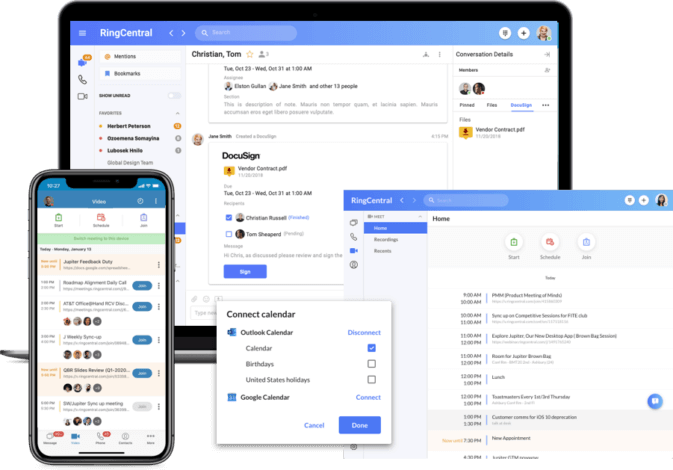
RingCentral continues to be a dominant Unified Communications as a Service (UCaaS) platform, integrating messaging, video interactions, and telephony (MVP) functionality into an adaptive cloud-centered ecosystem. Built to support enterprises of multiple scales, it delivers continuous teamwork and engagement across different devices, powered by a resilient, business-level framework.
The platform provides high-quality VoIP, immersive conferencing experiences, and consolidated collaboration tools, reinforced by AI-powered analytics and streamlined automation. Owing to its broad integration environment and trusted reliability, RingCentral empowers organizations to optimize efficiency and sustain consistent communication performance across worldwide operations.
Key Features
- Unified MVP Ecosystem: Merges voice services, digital meetings, and chat collaboration within a user-friendly interface accessible via desktop, smartphone, or browser-based clients.
- Business VoIP & PBX: Offers crystal-clear HD voice, virtual reception features, smart routing mechanisms, and global number management under unified control.
- AI-Enhanced Capabilities: Delivers live captions, noise suppression, automated meeting recaps, and comprehensive call data evaluation.
- Wide Integrations: Works seamlessly with over 300 enterprise-grade platforms, such as Microsoft 365, Google Workspace, Salesforce, and Slack.
Best For
Organizations requiring flexible, secure, and globally consistent communication systems—particularly suited for:
- Medium to large distributed teams
- Enterprises replacing outdated PBX infrastructures
- Businesses pursuing full CRM and productivity suite alignment.
3. Zoom Phone
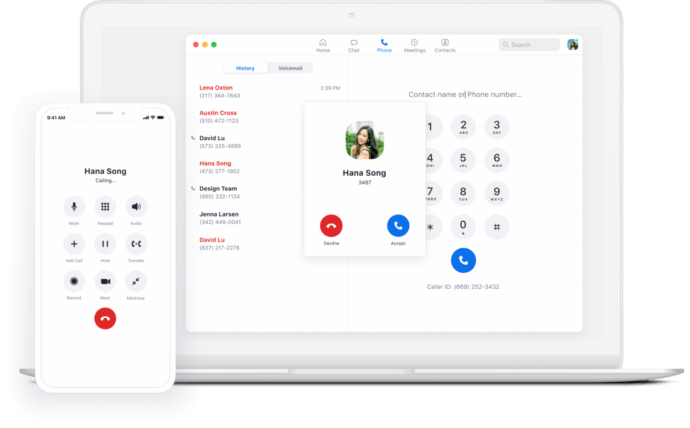
Zoom Phone enhances the renowned Zoom ecosystem with a cloud-based enterprise telephony solution that seamlessly integrates with Zoom Meetings and Team Chat. Tailored for dynamic hybrid workplaces, it unifies professional-grade calling and video collaboration within a single, streamlined communication hub.
Leveraging Zoom’s global infrastructure, this platform ensures reliable VoIP connectivity, adaptable deployment strategies, and extensive management functionality. It represents an excellent choice for organizations already using Zoom’s ecosystem and looking to advance toward a complete UC solution without migrating to another provider.
Key Features
- Cloud PBX Capabilities: Provides worldwide calling services, optimized routing options, virtual assistants, queue management, and flexible number portability across more than 40 international regions.
- Unified Workspace: Enables users to transition smoothly between voice calls, digital meetings, and group messaging through a single integrated platform, improving workflow consistency and team collaboration.
- AI-Driven Enhancements: Provides intelligent voicemail conversion, ambient sound suppression, and real-time analytical feedback to optimize communication accuracy and operational efficiency.
- Seamless Integrations: Connects flawlessly with Microsoft Teams, Salesforce, Slack, Google Workspace, and a wide range of enterprise-level applications.
- Centralized Management Console: Streamlines administrative oversight, routing configurations, and performance tracking via one unified and user-friendly interface.
Best For
Organizations currently operating Zoom Meetings that require flexible, unified telephony infrastructure with extensive global accessibility—particularly beneficial for:
- Remote and hybrid workgroups
- SMBs prioritizing simplicity and consolidated collaboration
- Large corporations pursuing effortless scalability within their existing Zoom ecosystem.
4. 8×8
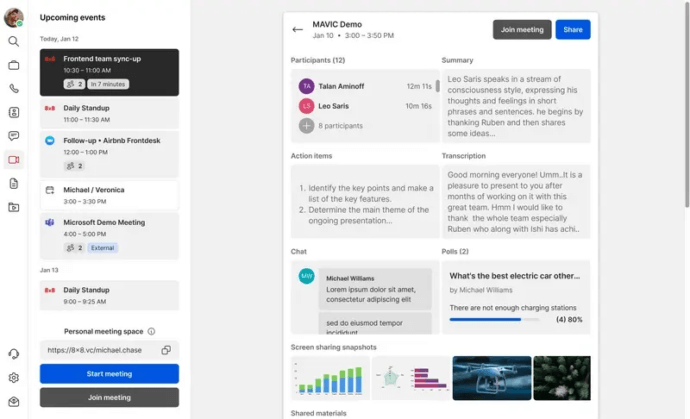
8×8 stands out as an international innovator in cloud-powered communications, providing a comprehensive, fully integrated ecosystem that merges Unified Communications (UCaaS), Contact Center (CCaaS), and CPaaS functionalities. Recognized under the name 8×8 XCaaS (Experience Communications as a Service), it establishes a cohesive framework for voice, video, chat, and customer interaction—positioning it as an ideal option for enterprises seeking to streamline internal collaboration and enhance external engagement through a singular connected platform.
The system’s flexibility, enterprise-level stability, and intelligent analytics establish it as a top-tier choice for organizations operating across multiple markets and customer-facing sectors.
Key Features
- Integrated UCaaS + CCaaS Framework: Combines business telephony, online conferencing, teamwork applications, and contact center operations within a single connected workspace.
- Worldwide VoIP Reach: Provides both local and toll-free access in more than 50 countries, ensuring consistent performance for geographically dispersed teams.
- AI & Insightful Analytics: Supplies voice intelligence, performance monitoring, and live engagement analysis powered by artificial intelligence.
- Advanced Security & Compliance: Adheres to strict data protection standards including GDPR, HIPAA, and ISO 27001, utilizing end-to-end encryption and resilient security controls.
Best For
Enterprises seeking a unified, international communication network supporting both employee collaboration and customer engagement—especially suitable for:
- Mid to large-scale corporations
- lobal organizations managing distributed teams
- Businesses combining UCaaS and contact center functionality.
5. Nextiva
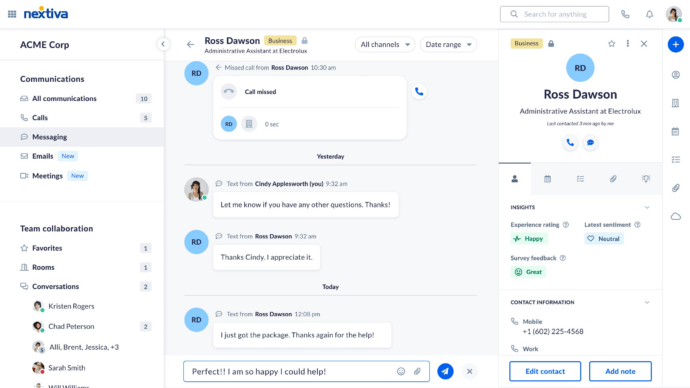
Nextiva distinguishes itself as a leading Unified Communications provider focused on simplicity, reliability, and outstanding customer interaction. Its cloud-based infrastructure unifies voice, video, messaging, and CRM capabilities within an elegant, user-centric environment. Celebrated for its responsive support and intuitive interface, Nextiva continues to be a preferred solution for small and medium-sized enterprises seeking enterprise-grade communications without unnecessary complication.
The organization’s dedication to usability, cost-effectiveness, and intelligent analytics makes it a trustworthy option for businesses striving to improve collaboration efficiency and enhance overall customer satisfaction.
Key Features
- Unified UC Environment: Merges telephony, video conferencing, chat, and team collaboration resources inside a cohesive, easily administered system.
- Integrated CRM & Insights: Provides built-in customer management functions with live call tracking and detailed performance evaluations.
- HD Voice & Video Solutions: Delivers superior call clarity, automated attendants, and flexible routing systems optimized for growing teams.
- Extensive Integrations: Connects effectively with popular enterprise tools including HubSpot, Salesforce, Microsoft Teams, and Google Workspace.
- Mobility & Accessibility: Offers cross-platform applications for desktop and mobile, ensuring uninterrupted communication anywhere.
Best For
Businesses looking for a straightforward, affordable, and robust hosted UC solution—particularly suitable for:
- Small to medium-sized companies
- Customer-oriented organizations and support centers
- Firms prioritizing engagement, reliability, and exceptional service quality.
6. Cisco Webex Calling
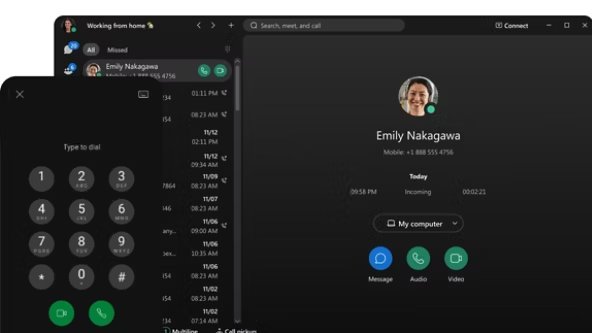
Cisco Webex Calling operates as an enterprise-grade cloud telephony and Unified Communications platform engineered for organizations emphasizing dependability, adaptability, and rigorous data protection. As a core component of the Cisco Collaboration Suite, it effortlessly integrates with Webex Meetings, Messaging, and Devices, creating a cohesive communication experience across multiple interaction channels.
Powered by Cisco’s industry-leading networking expertise and fortified security framework, Webex Calling ensures worldwide accessibility, superior sound and video performance, and extensive administrative oversight—making it a preferred choice for corporations and institutions overseeing complex communication infrastructures.
Key Features
- Enterprise-Grade Cloud PBX: Provides sophisticated telephony capabilities including auto attendants, call queue supervision, hunt group coordination, and international numbering configuration.
- Unified Collaboration Framework: Connects natively with Webex Meetings and Messaging, enabling users to move seamlessly between calls, messages, and video sessions without interruptions.
- AI-Powered Communication: Incorporates live background noise suppression, intelligent voice optimization, and automatic transcription to elevate clarity, inclusivity, and session quality.
- Hardware and Platform Compatibility: Functions seamlessly with Cisco IP endpoints, conferencing devices, and third-party productivity suites such as Microsoft 365 and Google Workspace.
- Enhanced Security Measures: Employs end-to-end encryption, multifactor verification, and adherence to enterprise-grade frameworks like ISO 27001 and GDPR.
- Centralized Management Hub: Via the Webex Control Center, IT managers can monitor user settings, implement compliance rules, and access detailed performance analytics through a unified interface.
Best For
Enterprises demanding a resilient, secure, and globally orchestrated communications network—ideally suited for:
- Large-scale corporations and international organizations
- Institutions leveraging existing Cisco infrastructure
- usinesses prioritizing compliance and advanced cybersecurity governance.
Key Advantages of Hosted UC
- 1. Cost Efficiency
One of the key financial benefits of Hosted UC lies in its overall cost efficiency. Conventional on-premises PBX infrastructures demand substantial initial spending on hardware procurement, upkeep, and dedicated IT resources. Hosted UC removes these financial burdens by transferring the complete communication framework into the cloud environment.
Organizations instead pay a consistent monthly subscription cost, which includes software updates, cybersecurity measures, and technical assistance. This operational expense (OpEx) structure enables companies to adjust capacity flexibly without large capital investments, making it a practical solution for both expanding businesses and emerging startups.
- 2. Scalability
Hosted UC platforms are engineered to evolve alongside the needs of an organization. Expanding user accounts, office locations, or available services can be accomplished immediately through an online administration console—eliminating the necessity for complicated setup processes or extra physical equipment.
Whether onboarding temporary staff or entering new regions, scalability guarantees that communication systems adapt as the business continues to grow. This level of flexibility proves particularly beneficial for remote or hybrid teams requiring agile and responsive communication capabilities.
- 3. Mobility
Contemporary business communication needs to be mobility-focused, and Hosted UC provides precisely that capability. Team members can initiate calls, participate in video sessions, and share messages from any connected device—be it smartphone, tablet, or laptop—from any location with internet access.
This level of mobility guarantees that teams stay efficient and engaged even while working off-site or traveling. Both mobile and desktop applications deliver uniform functionality, allowing for smooth device switching and preserving continuous workflow operations.
- 4. Reliability
Hosted UC solutions rely on resilient cloud architectures distributed throughout numerous global data centers. This redundant framework ensures maximum availability and continuous operations, even during regional disruptions or system malfunctions.
Leading providers deliver uptime assurances exceeding 99.99%, reinforced by automated failover protocols and robust disaster recovery mechanisms. Consequently, organizations can sustain seamless communication and collaboration, preserving client confidence and long-term operational reliability.
- 5. Simplified Management
Maintaining conventional PBX systems demands continuous upkeep, manual configuration, and frequent troubleshooting—all of which drain critical IT capacity. Hosted UC streamlines these operations by delegating system oversight to the external service provider.
Providers manage all essential components, including software maintenance, security enhancements, scaling, and performance monitoring, allowing internal teams to concentrate on higher-level strategic priorities. A user-friendly online dashboard offers administrators instant insight into system health and user control, eliminating the complex burdens of traditional on-premises infrastructure.
- 6. Integration Capabilities
A key advantage of Hosted UC lies in its capacity to connect effortlessly with a wide range of enterprise software tools such as no code CRM solutions, traditional CRMs (e.g., Salesforce, HubSpot), customer service platforms (e.g., Zendesk, Freshdesk), and productivity ecosystems (e.g., Microsoft 365, Google Workspace).
These deep integrations establish a cohesive operational workflow where communication data syncs automatically with existing business systems. For example, sales departments can initiate calls directly within CRM dashboards, while support teams access client interaction records during conversations. This approach not only boosts overall efficiency but also enhances user experience and promotes data-informed decision-making.
How to Choose the Right Hosted Unified Communications Provider
Choosing an appropriate Hosted UC provider relies on the organization’s individual goals, financial framework, and security expectations. Below are essential factors to evaluate:
1. Deployment Model: Decide among public, private, or hybrid environments depending on regulatory obligations and the desired level of operational control.
2. Feature Set: Assess whether the solution should include integrated video conferencing, real-time messaging, analytics, or contact center capabilities.
3. Security and Compliance: Verify encryption protocols, data locality policies, and certifications such as GDPR, HIPAA, or ISO 27001.
4. Integration Capabilities: Confirm seamless interoperability with current enterprise systems including CRM, ERP, and project management applications.
5. Support and Reliability: Seek round-the-clock assistance, service-level assurances, and a track record of consistent uptime.
6. Scalability and Pricing: Ensure the platform expands easily with organizational growth without hidden expenses or disruptive limitations.
Conclusion
Hosted Unified Communications is reshaping the way organizations communicate, cooperate, and function within the modern digital landscape. Through the adoption of a hosted UC framework, companies achieve greater flexibility, enhanced scalability, and optimized cost efficiency, all while enabling frictionless collaboration among teams—across locations and time zones.
Related posts:
Top Unified Communication Solutions for Enterprises in 2025
Communication Software for Efficient Work: New Possibilities
Best Secure Collaboration Tools in 2025
About the Author
Olga Afonina is a technology writer and industry expert specializing in video conferencing solutions and collaboration software. At TrueConf, she focuses on exploring the latest trends in collaboration technologies and providing businesses with practical insights into effective workplace communication. Drawing on her background in content development and industry research, Olga writes articles and reviews that help readers better understand the benefits of enterprise-grade communication.






Follow us on social networks